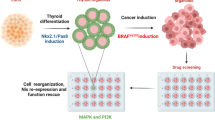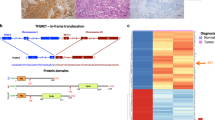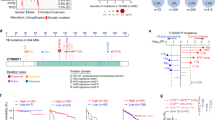Abstract
Most papillary thyroid carcinomas (PTC) have an isozyme-specific reduction of protein kinase C (PKC)ɛ, which occurs through a post-transcriptional mechanism. Here, we test whether the oncoprotein RET/PTC could be responsible for this effect, since RET/PTC rearrangements are quite prevalent in PTC and RET/PTC activates PLCγ, an upstream modulator of PKCs. At 3 h after induction of RET/PTC1 or RET/PTC3 expression, there was evidence of PKCɛ activation. Activation was restricted to PKCɛ, as acute expression of RET/PTC did not change the subcellular distribution of other PKC isozymes expressed in PCCL3 cells. Prolonged RET/PTC expression (2–6 days) produced an isozyme-specific change in PKCɛ subcellular localization and a decrease in total PKCɛ levels. The expression of RET/PTC3Y541F, which does not interact with PLCγ, but signals normally through other RET effectors, had no effect on PKCɛ distribution at any of the time points examined. However, downregulation of total PKCɛ levels was only partially prevented by expression of RET/PTCY541F. Cells with decreased PKCɛ following prolonged expression of RET/PTC were relatively resistant to doxorubicin-induced apoptosis. Based on our previous observation that PCCL3 cells expressing a dominant-negative PKCɛ are also markedly resistant to apoptosis, we propose that selective downregulation of PKCɛ following prolonged RET/PTC activation promotes cell survival and clonal expansion.
This is a preview of subscription content, access via your institution
Access options
Subscribe to this journal
Receive 50 print issues and online access
$259.00 per year
only $5.18 per issue
Buy this article
- Purchase on Springer Link
- Instant access to full article PDF
Prices may be subject to local taxes which are calculated during checkout






Similar content being viewed by others
References
Ahmad S, Mineta T, Martuza RL and Glazer RI . (1994). Neurosurgery, 35, 904–908.
Blobe GC, Obeid LM and Hannun YA . (1994). Cancer Metastasis Rev., 13, 411–431.
Borrello MG, Smith DP, Pasini B, Bongarzone I, Greco A, Lorenzo MJ, Arighi E, Miranda C, Eng C and Alberti L . (1995). Oncogene, 11, 2419–2427.
Cacace AM, Guadagno SN, Krauss RS, Fabbro D and Weinstein IB . (1993). Oncogene, 8, 2095–2104.
Castellone MD, Cirafici AM, De Vita G, De Falco V, Malorni L, Tallini G, Fagin JA, Fusco A, Melillo RM and Santoro M . (2003). Oncogene, 22, 246–255.
Dempsey EC, Newton AC, Mochly-Rosen D, Fields AP, Reyland ME, Insel PA and Messing RO . (2000). Am. J. Physiol. Lung Cell Mol. Physiol., 279, L429–L438.
DiGiovanni J . (1992). Pharmacol. Ther., 54, 63–128.
Downward J . (1998). Curr. Opin. Genet. Dev., 8, 49–54.
Durick K, Wu RY, Gill GN and Taylor SS . (1996). J. Biol. Chem., 271, 12691–12694.
Fagin JA . (2002). Endocrinology, 143, 2025–2028.
Fujimoto J and Brenner-Gati L . (1992). Endocrinology, 130, 1587–1592.
Fusco A, Berlingieri MT, Di Fiore PP, Portella G, Grieco M and Vecchio G . (1987). Mol. Cell Biol., 7, 3365–3370.
Gamard CJ, Blobe GC, Hannun YA and Obeid LM . (1994). Cell Growth Differ., 5, 405–409.
Gossen M and Bujard H . (1992). Proc. Natl. Acad. Sci. USA, 89, 5547–5551.
Gossen M and Bujard H . (1993). Nucleic. Acids. Res., 21, 4411–4412.
Gossen M, Freundlieb S, Bender G, Muller G, Hillen W and Bujard H . (1995). Science, 268, 1776–1769.
Hug H and Sarre TF . (1993). Biochem. J., 291, 329–343.
Kim MJ, Kim E, Ryu SH and Suh PG . (2000). Exp. Mol. Med., 32, 101–109.
Knauf JA, Elisei R, Mochly-Rosen D, Liron T, Chen XN, Gonsky R, Korenberg JR and Fagin JA . (1999). J. Biol. Chem., 274, 23414–23425.
Knauf JA, Ward LS, Nikiforov YE, Nikiforova M, Puxeddu E, Medvedovic M, Liron T, Mochly-Rosen D and Fagin JA . (2002). J. Clin. Endocrinol. Metab., 87, 2150–2159.
Lu Z, Liu D, Hornia A, Devonish W, Pagano M and Foster DA . (1998). Mol. Cell. Biol., 18, 839–845.
Maddens S, Charruyer A, Plo I, Dubreuil P, Berger S, Salles B, Laurent G and Jaffrezou JP . (2002). Blood, 100, 1294–1301.
Marks F and Gschwendt M . (1995). Mutat. Res., 333, 161–172.
Mikaelian I and Sergeant A . (1992). Nucleic Acids Res., 20, 376.
Mischak H, Goodnight JA, Kolch W, Martiny-Baron G, Schaechtle C, Kazanietz MG, Blumberg PM, Pierce JH and Mushinski JF . (1993). J. Biol. Chem., 268, 6090–6096.
Mochly-Rosen D and Gordon AS . (1998). FASEB J., 12, 35–42.
Muller PY, Janovjak H, Miserez AR and Dobbie Z . (2002). Biotechniques, 32, 1372–1379.
Murray NR and Fields AP . (1998). J. Biol. Chem., 273, 11514–11520.
Neri LM, Bortul R, Borgatti P, Tabellini G, Baldini G, Capitani S and Martelli AM . (2002). Mol. Biol. Cell, 13, 947–964.
O'Brian CA and Ward NE . (1989). Cancer Metastasis Rev., 8, 199–214.
Ohmori T and Arteaga CL . (1998). Cell Growth Differ., 9, 345–353.
Plo I, Lautier D, Casteran N, Dubreuil P, Arock M and Laurent G . (2001). Oncogene, 20, 6752–6763.
Ron D and Kazanietz MG . (1999). FASEB J., 13, 1658–1676.
Saavedra HI, Knauf JA, Shirokawa JM, Wang J, Ouyang B, Elisei R, Stambrook PJ and Fagin JA . (2000). Oncogene, 19, 3948–3954.
Santoro M, Melillo RM, Carlomagno F, Fusco A and Vecchio G . (2002). Ann. N.Y. Acad. Sci., 963, 116–121.
Sawai H, Okazaki T, Takeda Y, Tashima M, Sawada H, Okuma M, Kishi S, Umehara H and Domae N . (1997). J. Biol. Chem., 272, 2452–2458.
Schechtman D and Mochly-Rosen D . (2001). Oncogene, 20, 6339–6347.
Shinomura T, Asaoka Y, Oka M, Yoshida K and Nishizuka Y . (1991). Proc. Natl. Acad. Sci. USA, 88, 5149–5153.
Shirokawa JM, Elisei R, Knauf JA, Hara T, Wang J, Saavedra HI and Fagin JA . (2000). Mol. Endocrinol., 14, 1725–1738.
Vecchio G and Santoro M . (2000). Clin. Chem. Lab. Med., 38, 113–116.
Viglietto G, Chiappetta G, Martinez-Tello FJ, Fukunaga FH, Tallini G, Rigopoulou D, Visconti R, Mastro A, Santoro M and Fusco A . (1995). Oncogene, 11, 1207–1210.
Wang J, Knauf JA, Basu S, Puxeddu E, Kuroda H, Santoro M, Fusco A and Fagin JA . (2003). Mol. Endocrinol., 17, 1425–1436.
Wooten MW, Zhou G, Seibenhener ML and Coleman ES . (1994). Cell Growth Differ., 5, 395–403.
Zhuang S, Hirai S, Mizuno K, Suzuki A, Akimoto K, Izumi Y, Yamashita A and Ohno S . (1997). Biochem. Biophys. Res. Commun., 240, 273–278.
Acknowledgements
This work was supported in part by NIH Grants CA50706 and CA72597 (JAF), and K01DK02781 (JAK).
Author information
Authors and Affiliations
Corresponding author
Rights and permissions
About this article
Cite this article
Knauf, J., Ouyang, B., Croyle, M. et al. Acute expression of RET/PTC induces isozyme-specific activation and subsequent downregulation of PKCɛ in PCCL3 thyroid cells. Oncogene 22, 6830–6838 (2003). https://doi.org/10.1038/sj.onc.1206829
Received:
Revised:
Accepted:
Published:
Issue Date:
DOI: https://doi.org/10.1038/sj.onc.1206829



